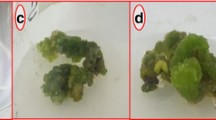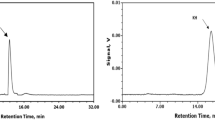Abstract
Linum usitatissimum: L. is well-known for production of pharmacologically important secondary metabolites. Due to their tremendous beneficial effects on human health, these compounds are receiving greater attention throughout the World, especially in the treatment of various types of cancers. In present study, we have developed an efficient protocol for production of lignans like secoisolariciresinol diglucoside (SDG) and lariciresinol diglucoside (LDG) and neo-lignans like dehydrodiconiferyl alcohol glucoside (DCG) and guaiacylglycerol-β-coniferyl alcohol ether glucoside (GGCG) by exploiting in vitro callus cultures of Flax. These cultures were established from stem and leaf explants, inoculated on Murashige and Skoog (MS) media supplemented with various concentrations of α-naphthalene acetic acid (NAA), thidiazuron (TDZ) and 6-benzyl adenine (BA). Results revealed that the leaf-derived calli (1.0 mg/l NAA) accumulated highest levels of biomass (DW; 15.7 g/l) and antioxidant activity, while highest production of total phenolics (111.09 mg/l) and flavonoids (45.02 mg/l) were observed in stem-derived calli (1.0 mg/l NAA). The high-performance liquid chromatography (HPLC) analysis revealed that the stem-derived calli (1.0 mg/l NAA) accumulated optimum concentrations of SDG (2.7 ± 0.021 mg/g DW), LDG (9.8 ± 0.062 mg/g DW) and DCG (13.8 ± 0.076 mg/g DW), while leaf-derived calli (1.0 mg/l NAA) showed optimum accumulation of GGCG (3.8 ± 0.022 mg/g DW) as compared to all other treatments. These results provided definite evidence that the NAA differentially influence the production of lignans and neo-lignans in callus culture of Flax. This study opens new dimensions to devise strategies to enhance the production of these valuable metabolites.








Similar content being viewed by others
Abbreviations
- ABTS:
-
2, 2′-Azino-bis-3-ethylbenzothiazoline-6-sulphonic acid
- BA:
-
6-Benzyl adenine
- DCG:
-
Dehydrodiconiferyl alcohol glucoside
- DPPH:
-
2, 2-Diphenyl-1-picrylhydrazyl
- FRSA:
-
Free radical scavenging activity
- GGCG:
-
Guaiacylglycerol-β-coniferyl alcohol ether glucoside
- LDG:
-
Lariciresinol diglucoside
- MAT:
-
Matairesinol
- NAA:
-
α-naphthalene acetic acid
- SDG:
-
Secoisolariciresinol diglucoside
- SECO:
-
Secoisolariciresinol
- TDZ:
-
Thidiazuron
- TFC:
-
Total flavonoid content
- TPC:
-
Total phenolic content
References
Abbasi BH, Khan M, Guo B, Bokhari SA, Khan MA (2011) Efficient regeneration and antioxidative enzyme activities in Brassica rapa var. turnip. Plant Cell Tissue Organ Culture (PCTOC 105:337–344
Adlercreutz H (2007) Lignans and human health. Crit Rev Clin Lab Sci 44:483–525
Al Abdallat A, Sawwan J, Al Zoubi B (2011) Agrobacterium tumefaciens-mediated transformation of callus cells of Crataegus aronia. Plant Cell Tissue Organ Culture (PCTOC 104:31–39
Ali M, Abbasi BH (2013) Production of commercially important secondary metabolites and antioxidant activity in cell suspension cultures of Artemisia absinthium L. Ind Crops Prod 49:400–406
Ali M, Abbasi BH (2014) Thidiazuron-induced changes in biomass parameters, total phenolic content, and antioxidant activity in callus cultures of Artemisia absinthium L. Appl Biochem Biotechnol 172:2363–2376
Anjum S, Abbasi BH (2016) Thidiazuron-enhanced biosynthesis and antimicrobial efficacy of silver nanoparticles via improving phytochemical reducing potential in callus culture of Linum usitatissimum L. Int J Nanomed 11:715
Attoumbré J et al (2006) High accumulation of dehydrodiconiferyl alcohol-4-β-d-glucoside in free and immobilized Linum usitatissimum cell cultures. Plant Cell Rep 25:859–864
Bahorun T, Aumjaud E, Ramphul H, Rycha M, Luximon-Ramma A, Trotin F, Aruoma OI (2003) Phenolic constituents and antioxidant capacities of Crataegus monogyna (Hawthorn) callus extracts. Food/Nahrung 47:191–198
Bahri-Sahloul R et al. (2014) Phenolic composition and antioxidant and antimicrobial activities of extracts obtained from Crataegus azarolus L. var. aronia (Willd.) Batt. ovaries calli. J Bot
Beejmohun V et al (2007) Coniferin dimerisation in lignan biosynthesis in flax cells. Phytochemistry 68:2744–2752
Chaâbani G et al. (2015) Effects of 2, 4-dichlorophenoxyacetic acid combined to 6-Benzylaminopurine on callus induction, total phenolic and ascorbic acid production, and antioxidant activities in leaf tissue cultures of Crataegus azarolus L. var. aronia. Acta Physiol Plant 37:1–9
Chang C-C, Yang M-H, Wen H-M, Chern J-C (2002) Estimation of total flavonoid content in propolis by two complementary colorimetric methods. J Food Drug Anal 10
Cheng H, Yu L-J, Hu Q-Y, Chen S-C, Sun Y-P (2006) Establishment of callus and cell suspension cultures of Corydalis saxicola Bunting, a rare medicinal plant. Zeitschrift für Naturforschung C 61:251–256
Corbin C et al (2015) Development and validation of an efficient ultrasound assisted extraction of phenolic compounds from flax (Linum usitatissimum L.) seeds. Ultrason Sonochem 26:176–185
Coste A, Vlase L, Halmagyi A, Deliu C, Coldea G (2011) Effects of plant growth regulators and elicitors on production of secondary metabolites in shoot cultures of Hypericum hirsutum and Hypericum maculatum. Plant Cell Tissue Organ Culture (PCTOC 106:279–288
da Cunha ACG, Ferreira MF (1996) Somatic embryogenesis, organogenesis and callus growth kinetics of flax. Plant Cell Tissue Organ Culture (PCTOC) 47:1–8
Danya U, Udhayasankar M, Punitha D, Arumugasamy K, Suresh S (2012) In vitro regeneration of Tecomella undulata (Sm.) Seem-an endangered medicinal plant. Int J Plant Anim Environ Sci 2:44–49
Djeridane A, Yousfi M, Nadjemi B, Boutassouna D, Stocker P, Vidal N (2006) Antioxidant activity of some Algerian medicinal plants extracts containing phenolic compounds. Food Chem 97:654–660
Duncan DB (1955) Multiple range and multiple F tests. Biometrics 11:1–42
El-Baz FK, Mohamed AA, Ali SI (2010) Callus formation, phenolics content and related antioxidant activities in tissue culture of a medicinal plant colocynth (Citrullus colocynthis). Nova Biotechnol 10:79–94
Fazal H, Abbasi BH, Ahmad N (2014) Optimization of adventitious root culture for production of biomass and secondary metabolites in Prunella vulgaris L. Appl Biochem Biotechnol 174:2086–2095
Fliniaux O et al (2014) Microwave-assisted extraction of herbacetin diglucoside from flax (Linum usitatissimum L.) seed cakes and its quantification using an RP-HPLC-UV system. Molecules 19:3025–3037
Floegel A, Kim D-O, Chung S-J, Koo SI, Chun OK (2011) Comparison of ABTS/DPPH assays to measure antioxidant capacity in popular antioxidant-rich US foods. Journal of food composition analysis 24:1043–1048
Ford JD, Huang K-S, Wang H-B, Davin LB, Lewis NG (2001) Biosynthetic pathway to the cancer chemopreventive secoisolariciresinol diglucoside-hydroxymethyl glutaryl ester-linked lignan oligomers in flax (Linum u sitatissimum) Seed. J Nat Prod 64:1388–1397
Gabr AM, Mabrok HB, Ghanem KZ, Blaut M, Smetanska I (2016) Lignan accumulation in callus and Agrobacterium rhizogenes-mediated hairy root cultures of flax (Linum usitatissimum). Plant Cell Tissue Organ Culture (PCTOC) 1–13
Grzegorczyk I, Matkowski A, Wysokińska H (2007) Antioxidant activity of extracts from in vitro cultures of Salvia officinalis L. Food Chem 104:536–541
Hano C et al (2006) Differential accumulation of monolignol-derived compounds in elicited flax (Linum usitatissimum) cell suspension cultures. Planta 223:975–989
Hano C et al (2013) Flaxseed (Linum usitatissimum L.) extract as well as (+)-secoisolariciresinol diglucoside and its mammalian derivatives are potent inhibitors of α-amylase activity. Bioorganic medicinal chemistry letters 23:3007–3012
Heimbach J (2009) Determination of the generally recognized as safe status of the addition of whole and milled flaxseed to conventional foods and meat and poultry products. Flax Canada 2015:1
Huang D, Ou B, Prior RL (2005) The chemistry behind antioxidant capacity assays. J Agric Food Chem 53:1841–1856
Jain P, Rashid A (2001) Stimulation of shoot regeneration on Linum hypocotyl segments by thidiazuron and its response to light and calcium. Biol Plant 44:611–613
Janowicz J, Niemann J, Wojciechowski A (2012) The effect of growth regulators on the regeneration ability of flax (Linum usitatissimum L.) hypocotyl explants in in vitro culture. BioTechnol J Biotechnol Comput Biol Bionanotechnol 93
Kartnig T, Kögl G, Heydel B (1993) Production of flavonoids in cell cultures of Crataegus monogyna. Plant Med 59:537–538
Kim D-O, Chun OK, Kim YJ, Moon H-Y, Lee CY (2003) Quantification of polyphenolics and their antioxidant capacity in fresh plums. J Agric Food Chem 51:6509–6515
Kosińska A, Penkacik K, Wiczkowski W, Amarowicz R (2011) Presence of caffeic acid in flaxseed lignan macromolecule. Plant foods for human nutrition 66:270–274
Lisowska K, Wysokinska H (2000) In vitro propagation of Catalpa ovata G. Don. Plant Cell Tissue Organ Culture (PCTOC) 60:171–176
Liu Z, Saarinen NM, Thompson LU (2006) Sesamin is one of the major precursors of mammalian lignans in sesame seed (Sesamum indicum) as observed in vitro and in rats. J Nutr 136:906–912
Maharik N, Elgengaihi S, Taha H (2009) Anthocyanin production in callus cultures of Crataegus sinaica boiss. Int J Acad Res 1:30–34
Mathur S, Shekhawat GS (2013) Establishment and characterization of Stevia rebaudiana (Bertoni) cell suspension culture: an in vitro approach for production of stevioside. Acta Physiol Plant 35:931–939
Mejía D (2007) FAO (Food and Agriculture Organization of the United Nations)
Millam S, Obert B, Pret’ová A (2005) Plant cell and biotechnology studies in Linum usitatissimum—a review. Plant Cell Tissue Organ Culture (PCTOC) 82:93–103
Murashige T, Skoog F (1962) A revised medium for rapid growth and bio assays with tobacco tissue cultures. Physiol Plant 15:473–497
Palla AH, Khan NA, Bashir S, Iqbal J, Gilani A-H (2015) Pharmacological basis for the medicinal use of Linum usitatissimum (Flaxseed) in infectious and non-infectious diarrhea. J Ethnopharmacol 160:61–68
Prasad K (1997) Dietary flax seed in prevention of hypercholesterolemic atherosclerosis. Atherosclerosis 132:69–76
Ramawat K, Mathur M (2007) Factors affecting production of secondary metabolites. Biotechnology secondary metabolites Science. Enfield 59–101
Rasool R, Ganai BA, Kamili AN, Akbar S (2012) Antioxidant potential in callus culture of Artemisia amygdalina Decne. Nat Prod Res 26:2103–2106
Ray B, Hassan L, Nasiruddin K (2011) In vitro regeneration of brinjal (Solanum melongena L.). Bangladesh J Agric Res 36:397–406
Rickard-Bon SE, Thompson LU (2003) The role of flaxseed lignans in hormone-dependent and independent cancer Flax. Genus Linum 181–203
Sasheva P, Letkarska G, Ionkova I (2013) Biotechnological production of podophyllotoxin and podophyllotoxin-related lignans in cultures of Linum thracicum Degen. Comptes Rendus de l’Academie bulgare des Sciences 66:1445–1450
Schaich K, Tian X, Xie J (2015) Hurdles and pitfalls in measuring antioxidant efficacy: a critical evaluation of ABTS, DPPH, and ORAC assays. J Funct Foods 14:111–125
Schmidt TJ et al (2010) Lignans in flowering aerial parts of Linum species–chemodiversity in the light of systematics and phylogeny. Phytochemistry 71:1714–1728
Shim YY, Gui B, Arnison PG, Wang Y, Reaney MJ (2014) Flaxseed (Linum usitatissimum L.) bioactive compounds and peptide nomenclature: a review. Trends Food Sci Technol 38:5–20
Siegień I, Adamczuk A, Wróblewska K (2013) Light affects in vitro organogenesis of Linum usitatissimum L. and its cyanogenic potential. Acta Physiol Plant 35:781–789
Szewczyk M, Abarzua S, Schlichting A, Nebe B, Piechulla B, Briese V, Richter D-U (2014) Effects of extracts from Linum usitatissimum on cell vitality, proliferation and cytotoxicity in human breast cancer cell lines. J Med Plants Res 8:237–245
Tagliazucchi D, Verzelloni E, Bertolini D, Conte A (2010) In vitro bio-accessibility and antioxidant activity of grape polyphenols. Food Chem 120:599–606
Touré A, Xueming X (2010) Flaxseed lignans: source, biosynthesis, metabolism, antioxidant activity, bio-active components, and health benefits. Comprehen Rev Food Sci Food Safe 9:261–269
Turner T, Mapiye C, Aalhus J, Beaulieu A, Patience J, Zijlstra R, Dugan M (2014) Flaxseed fed pork: n–3 fatty acid enrichment and contribution to dietary recommendations. Meat Sci 96:541–547
Velioglu Y, Mazza G, Gao L, Oomah B (1998) Antioxidant activity and total phenolics in selected fruits, vegetables, and grain products. J Agric Food Chem 46:4113–4117
Wang L-Q, Meselhy MR, Li Y, QIN G-W, Hattori M (2000) Human intestinal bacteria capable of transforming secoisolariciresinol diglucoside to mammalian lignans, enterodiol and enterolactone. Chem Pharmaceut Bull 48:1606–1610
Author contributions
SA did the research work, data analyses and manuscript write-up. BHA conceived the idea, supervised the research work and critically reviewed the manuscript. CH performed the HPLC analyses.
Author information
Authors and Affiliations
Corresponding author
Ethics declarations
Conflict of interest
The authors declare that they have no conflict of interest.
Rights and permissions
About this article
Cite this article
Anjum, S., Abbasi, B.H. & Hano, C. Trends in accumulation of pharmacologically important antioxidant-secondary metabolites in callus cultures of Linum usitatissimum L.. Plant Cell Tiss Organ Cult 129, 73–87 (2017). https://doi.org/10.1007/s11240-016-1158-3
Received:
Accepted:
Published:
Issue Date:
DOI: https://doi.org/10.1007/s11240-016-1158-3




